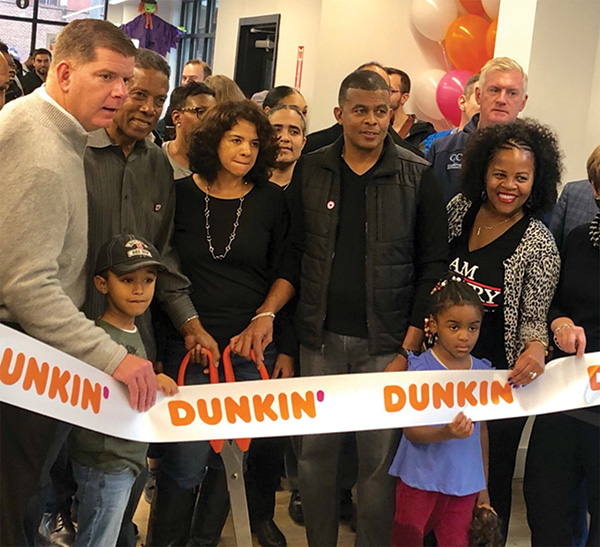
Linda Turnbull, director of administration and human resources of The Waldwin Group;
Kevin Reynolds, director of operations of The Waldwin Group;
John Curtis, president of Curtis Construction; and Kim Janey, Boston city councilor
Roxbury, MA A Nor’easter couldn’t dampen the festivities at the Archer Bonell ribbon cutting ceremony on October 27th. Boston mayor Marty Walsh was on hand to help cut the ribbon on much needed housing in the Dudley Sq. area. Located across from the B-2 police station, this mix-use development was developed by The Waldwin Group, a local Dunkin Donuts franchisee. The Timothy Burke Architecture designed building sits on what was three empty city-owned lots filled with trash and abandoned vehicles. Totaling 14,000 s/f, over 2,000 tons of fill was removed to make way for the 20,000 s/f building. The project includes nine two-bedroom, three one-bedroom luxury units; the first-floor retail space includes a Dunkin Donuts and a tenant to be named at a later date.
The Waldwin Group engaged Curtis Construction as construction manager to provide pre-construction and construction management services. Having managed many urban projects, Curtis knew collaboration during the pre-construction stage was essential for the project to be successful. All subcontractors and product manufacturers were made aware of site conditions and issues such as deliveries, storage, and worker parking were addressed early in the planning stage which reduced potential complications that could arise on a site located in a busy, congested section of the city. Curtis carefully choreographed the sequencing of the regulated soil disposal in a manner that minimized costs while opening up the site for additional construction activities.
Each unit have hardwood floors throughout; recessed lighting; kitchen with island; in-unit laundry and an accommodating open-concept design. There is a gym and landscaped deck on the roof that is open to residents.
Dudley Sq. is considered a corridor for job creation, commerce, and transit-oriented development. Part of the city of Boston’s Roxbury Strategic Master Plan and Dudley Vision, the Archer Bonell project brings much needed housing to the Dudley Sq. area, 15% of the units are affordable housing, meeting the city’s Inclusionary Development Policy requirements. The empty lots are no longer an eyesore, gone are the trash and abandoned vehicles, all part of the city’s efforts to revitalize the neighborhood.
 (1).jpg)







.png)